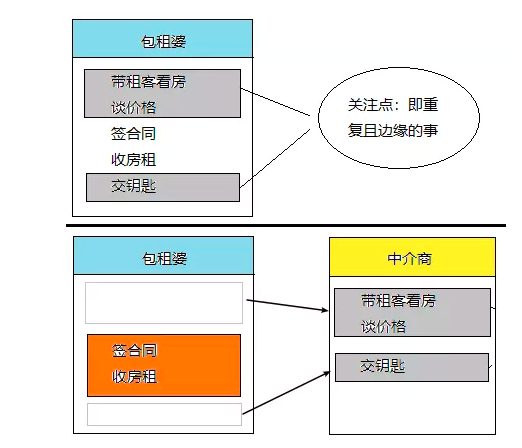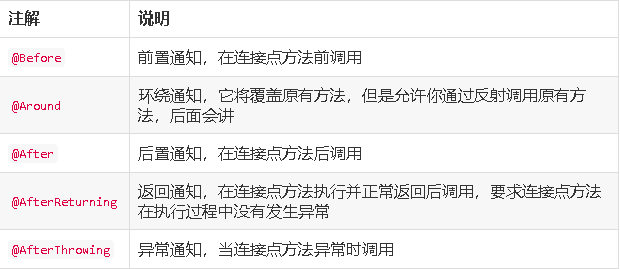-
Spring AOP 简介
如果说 IoC 是 Spring 的核心,那么面向切面编程就是 Spring 最为重要的功能之一了,在数据库事务中切面编程被广泛使用。
AOP 即 Aspect Oriented Program 面向切面编程
首先,在面向切面编程的思想里面,把功能分为核心业务功能,和周边功能。
- 所谓的核心业务,比如登陆,增加数据,删除数据都叫核心业务
- 所谓的周边功能,比如性能统计,日志,事务管理等等
周边功能在 Spring 的面向切面编程AOP思想里,即被定义为切面
在面向切面编程AOP的思想里面,核心业务功能和切面功能分别独立进行开发,然后把切面功能和核心业务功能 "编织" 在一起,这就叫AOP
AOP 的目的
AOP能够将那些与业务无关,却为业务模块所共同调用的逻辑或责任(例如事务处理、日志管理、权限控制等)封装起来,便于减少系统的重复代码,降低模块间的耦合度,并有利于未来的可拓展性和可维护性。
AOP 当中的概念:
- 切入点(Pointcut)
在哪些类,哪些方法上切入(where) - 通知(Advice)
在方法执行的什么实际(when:方法前/方法后/方法前后)做什么(what:增强的功能) - 切面(Aspect)
切面 = 切入点 + 通知,通俗点就是:在什么时机,什么地方,做什么增强! - 织入(Weaving)
把切面加入到对象,并创建出代理对象的过程。(由 Spring 来完成)
为了更好的说明 AOP 的概念,我们来举一个实际中的例子来说明:

在上面的例子中,包租婆的核心业务就是签合同,收房租,那么这就够了,灰色框起来的部分都是重复且边缘的事,交给中介商就好了,这就是 AOP 的一个思想:让关注点代码与业务代码分离!
我们来实际的用代码感受一下
1 package pojo; 2 3 import org.springframework.stereotype.Component; 4 5 @Component("landlord") 6 public class Landlord { 7 8 public void service() { 9 // 仅仅只是实现了核心的业务功能 10 System.out.println("签合同"); 11 System.out.println("收房租"); 12 } 13 }
1 package aspect; 2 3 import org.aspectj.lang.annotation.After; 4 import org.aspectj.lang.annotation.Aspect; 5 import org.aspectj.lang.annotation.Before; 6 import org.springframework.stereotype.Component; 7 8 @Component 9 @Aspect 10 class Broker { 11 12 @Before("execution(* pojo.Landlord.service())") 13 public void before(){ 14 System.out.println("带租客看房"); 15 System.out.println("谈价格"); 16 } 17 18 @After("execution(* pojo.Landlord.service())") 19 public void after(){ 20 System.out.println("交钥匙"); 21 } 22 }
在 applicationContext.xml 中配置自动注入,并告诉 Spring IoC 容器去哪里扫描这两个 Bean:
1 <?xml version="1.0" encoding="UTF-8"?> 2 <beans xmlns="http://www.springframework.org/schema/beans" 3 xmlns:xsi="http://www.w3.org/2001/XMLSchema-instance" 4 xmlns:context="http://www.springframework.org/schema/context" 5 xmlns:aop="http://www.springframework.org/schema/aop" 6 xsi:schemaLocation="http://www.springframework.org/schema/beans 7 http://www.springframework.org/schema/beans/spring-beans.xsd http://www.springframework.org/schema/context http://www.springframework.org/schema/context/spring-context.xsd http://www.springframework.org/schema/aop http://www.springframework.org/schema/aop/spring-aop.xsd"> 8 9 <context:component-scan base-package="aspect" /> 10 <context:component-scan base-package="pojo" /> 11 12 <aop:aspectj-autoproxy/> 13 </beans>
测试代码
1 package test; 2 3 import org.springframework.context.ApplicationContext; 4 import org.springframework.context.support.ClassPathXmlApplicationContext; 5 import pojo.Landlord; 6 7 public class TestSpring { 8 9 public static void main(String[] args) { 10 11 ApplicationContext context = 12 new ClassPathXmlApplicationContext("applicationContext.xml"); 13 Landlord landlord = (Landlord) context.getBean("landlord", Landlord.class); 14 landlord.service(); 15 16 } 17 }
执行结果

使用注解来开发 Spring AOP
使用注解的方式已经逐渐成为了主流,所以我们利用上面的例子来说明如何用注解来开发 Spring AOP
第一步:选择连接点
Spring 是方法级别的 AOP 框架,我们主要也是以某个类额某个方法作为连接点,另一种说法就是:选择哪一个类的哪一方法用以增强功能。

我们在这里就选择上述 Landlord 类中的 service() 方法作为连接点。
第二步:创建切面
选择好了连接点就可以创建切面了,我们可以把切面理解为一个拦截器,当程序运行到连接点的时候,被拦截下来,在开头加入了初始化的方法,在结尾也加入了销毁的方法而已,在 Spring 中只要使用 @Aspect 注解一个类,那么 Spring IoC 容器就会认为这是一个切面了:
1 package aspect; 2 3 import org.aspectj.lang.annotation.After; 4 import org.aspectj.lang.annotation.Aspect; 5 import org.aspectj.lang.annotation.Before; 6 import org.springframework.stereotype.Component; 7 8 @Component 9 @Aspect 10 class Broker { 11 12 @Before("execution(* pojo.Landlord.service())") 13 public void before(){ 14 System.out.println("带租客看房"); 15 System.out.println("谈价格"); 16 } 17 18 @After("execution(* pojo.Landlord.service())") 19 public void after(){ 20 System.out.println("交钥匙"); 21 } 22 }
- 注意: 被定义为切面的类仍然是一个 Bean ,需要
@Component注解标注

有了上表,我们就知道 before() 方法是连接点方法调用前调用的方法,而 after() 方法则相反,这些注解中间使用了定义切点的正则式,也就是告诉 Spring AOP 需要拦截什么对象的什么方法,下面讲到。
第三步:定义切点
在上面的注解中定义了 execution 的正则表达式,Spring 通过这个正则表达式判断具体要拦截的是哪一个类的哪一个方法:
1 execution(* pojo.Landlord.service())
依次对这个表达式作出分析:
- execution:代表执行方法的时候会触发
*:代表任意返回类型的方法- pojo.Landlord:代表类的全限定名
- service():被拦截的方法名称
通过上面的表达式,Spring 就会知道应该拦截 pojo.Lnadlord 类下的 service() 方法。上面的演示类还好,如果多出都需要写这样的表达式难免会有些复杂,我们可以通过使用 @Pointcut 注解来定义一个切点来避免这样的麻烦:
1 package aspect; 2 3 import org.aspectj.lang.annotation.After; 4 import org.aspectj.lang.annotation.Aspect; 5 import org.aspectj.lang.annotation.Before; 6 import org.aspectj.lang.annotation.Pointcut; 7 import org.springframework.stereotype.Component; 8 9 @Component 10 @Aspect 11 class Broker { 12 13 @Pointcut("execution(* pojo.Landlord.service())") 14 public void lService() { 15 } 16 17 @Before("lService()") 18 public void before() { 19 System.out.println("带租客看房"); 20 System.out.println("谈价格"); 21 } 22 23 @After("lService()") 24 public void after() { 25 System.out.println("交钥匙"); 26 } 27 }
测试结果
